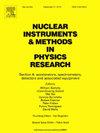Handheld multipurpose radionuclide identification device employing multilayered phoswich technology
IF 1.5
3区 物理与天体物理
Q3 INSTRUMENTS & INSTRUMENTATION
Nuclear Instruments & Methods in Physics Research Section A-accelerators Spectrometers Detectors and Associated Equipment
Pub Date : 2025-03-17
DOI:10.1016/j.nima.2025.170437
引用次数: 0
Abstract
Handheld radionuclide identification devices (RIDs) are widely used by personnel in homeland security organizations, regulatory authorities, the nuclear energy industry, environmental monitoring, etc., to detect and identify gamma-ray-emitting radionuclides. Many RIDs also include a neutron detector. However, most operationally used RIDs do not provide directional information on gamma-rays and lack the capability of detecting alpha and beta radiation thereby requiring the user to carry multiple devices. Here, we introduce and demonstrate a multipurpose RID that enables rapid interactive directional sensing of a gamma-ray source, can directly and indirectly detect neutrons, and measure alpha and beta radiation from contaminated surfaces. The developed multipurpose detector enables establishing initial situational awareness with a single instrument. This facilitates the work of frontline officers significantly. The sensor fusion required for instrument compactness and multipurposity was achieved by employing phoswich technology and integrated digital electronics. The performance of the prototype device developed is demonstrated in practice using well-known radioactive reference sources. The device has a higher energy range for gamma-rays (from ∼50 keV to above 4.4 MeV) than typical RIDs, enabling indirect detection and characterization of neutron sources. Despite the high level of integration, determined gamma-ray energy resolution and detection sensitivity for gamma-rays, alpha and beta radiation, are comparable to commercially available RIDs and surface contamination monitors. The developed technology can also be applied to other categories of radiation detection instruments.
采用多层光导技术的手持式多用途放射性核素识别装置
手持式放射性核素识别装置(rid)被国土安全组织、监管机构、核能工业、环境监测等部门的人员广泛用于探测和识别伽马射线发射的放射性核素。许多rid还包括一个中子探测器。但是,大多数实际使用的rid不提供关于伽马射线的方向信息,并且缺乏探测α和β辐射的能力,因此需要用户携带多个设备。在这里,我们介绍并演示了一种多用途RID,它可以实现伽马射线源的快速交互式定向传感,可以直接和间接地检测中子,并测量来自污染表面的α和β辐射。开发的多用途探测器能够通过单一仪器建立初始态势感知。这大大方便了前线人员的工作。采用光敏技术和集成数字电子技术,实现了仪器紧凑和多用途所需的传感器融合。所开发的原型装置的性能在使用著名的放射性参考源的实践中得到了验证。该装置具有比典型rid更高的伽马射线能量范围(从~ 50 keV到4.4 MeV以上),能够间接检测和表征中子源。尽管集成度很高,但确定的伽马射线能量分辨率和对伽马射线、α和β辐射的探测灵敏度可与市售rid和表面污染监测仪相媲美。所开发的技术也可应用于其他类型的辐射探测仪器。
本文章由计算机程序翻译,如有差异,请以英文原文为准。
求助全文
约1分钟内获得全文
求助全文
来源期刊
CiteScore
3.20
自引率
21.40%
发文量
787
审稿时长
1 months
期刊介绍:
Section A of Nuclear Instruments and Methods in Physics Research publishes papers on design, manufacturing and performance of scientific instruments with an emphasis on large scale facilities. This includes the development of particle accelerators, ion sources, beam transport systems and target arrangements as well as the use of secondary phenomena such as synchrotron radiation and free electron lasers. It also includes all types of instrumentation for the detection and spectrometry of radiations from high energy processes and nuclear decays, as well as instrumentation for experiments at nuclear reactors. Specialized electronics for nuclear and other types of spectrometry as well as computerization of measurements and control systems in this area also find their place in the A section.
Theoretical as well as experimental papers are accepted.

 求助内容:
求助内容: 应助结果提醒方式:
应助结果提醒方式:


